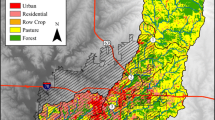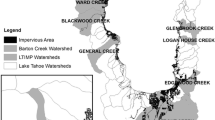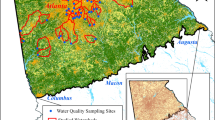Abstract
Effective water quality management of streams in urbanized basins requires identification of the elements of urbanization that contribute most to pollutant concentrations and loads. Drainage connection (the proportion of impervious area directly connected to streams by pipes or lined drains) is proposed as a variable explaining variance in the generally weak relationships between pollutant concentrations and imperviousness. Fifteen small streams draining independent subbasins east of Melbourne, Australia, were sampled for a suite of water quality variables. Geometric mean concentrations of all variables were calculated separately for baseflow and storm events, and these, together with estimates of runoff derived from a rainfall-runoff model, were used to estimate mean annual loads. Patterns of concentrations among the streams were assessed against patterns of imperviousness, drainage connection, unsealed (unpaved) road density, elevation, longitude (all of which were intercorrelated), septic tank density, and basin area. Baseflow and storm event concentrations of dissolved organic carbon (DOC), filterable reactive phosphorus (FRP), total phosphorus (TP) and ammonium, along with electrical conductivity (EC), all increased with imperviousness and its correlates. Hierarchical partitioning showed that DOC, EC, FRP, and storm event TP were independently correlated with drainage connection more strongly than could be explained by chance. Neither pH nor total suspended solids concentrations were strongly correlated with any basin variable. Oxidized and total nitrogen concentrations were most strongly explained by septic tank density. Loads of all variables were strongly correlated with imperviousness and connection. Priority should be given to low-impact urban design, which primarily involves reducing drainage connection, to minimize urbanization-related pollutant impacts on streams.




Similar content being viewed by others
Literature Cited
AMHA-AWWA-WPCF. 1998. Standard methods for the examination of water and wastewater. American Public Health Association, American Water Works Association, Water Pollution Control Federation, Washington, D.C.
C. L. Jr. Arnold C. J. Gibbons (1996) ArticleTitleImpervious surface coverage: The emergence of a key environmental indicator Journal of the American Planning Association 62 243–258
P. M. Attiwill P. J. Polglase C. J. Weston M. A. Adams (1996) Nutrient cycling in forest of south-eastern Australia, Pages 191–227 M. A. Adams P. M. Attiwill (Eds) Nutrition of eucalypts CSIRO Melbourne
R. T. Bannerman D. W. Owens R. B. Dodds N. J. Hornewer (1993) ArticleTitleSources of pollutants in Wisconsin stormwater Water Science and Technology 28 241–259 Occurrence Handle1:CAS:528:DyaK2cXosFyrug%3D%3D
D. B. Booth C. R. Jackson (1997) ArticleTitleUrbanization of aquatic systems—degradation thresholds, stormwater detention, and the limits of mitigation Journal of the American Water Resources Association 33 1077–1090
P. L. Brezonik T. H. Stadelmann (2002) ArticleTitleAnalysis and predictive models of stormwater runoff volumes, loads, and pollutant concentrations from watersheds in the Twin Cities metropolitan area, Minnesota, USA Water Research 36 1743–1757 Occurrence Handle10.1016/S0043-1354(01)00375-X Occurrence Handle1:CAS:528:DC%2BD38XislykurY%3D Occurrence Handle12044074
S. R. Carpenter N. F. Caraco D. L. Correll R. W. Howarth A. N. Sharpley V. H. Smith (1998) ArticleTitleNonpoint pollution of surface waters with phosphorus and nitrogen Ecological Applications 8 559–568
InstitutionalAuthorNameCenter for Watershed Protection (2003) Impacts of impervious cover on aquatic ecosystems Center for Watershed Protection Ellicott City, Maryland 142
R. J. Charbeneau M. E. Barrett (1998) ArticleTitleEvaluation of methods for estimating stormwater pollutant loads Water Environment Research 70 1295–1302 Occurrence Handle1:CAS:528:DyaK1MXlt1Orsg%3D%3D
A. Chevan M. Sutherland (1991) ArticleTitleHierarchical partitioning The American Statistician 45 90–96
F. H. S. Chiew T. A. McMahon (1999) ArticleTitleModelling runoff and diffuse pollution loads in urban areas Water Science and Technology 39 241–248 Occurrence Handle10.1016/S0273-1223(99)00340-6 Occurrence Handle1:CAS:528:DyaK1MXmtV2nsro%3D
Duncan, H. P. 1999. Urban stormwater quality: A statistical overview. Cooperative Research Centre for Catchment Hydrology, Melbourne, Australia, 80 pp.
S. E. Gergel M. G. Turner J. R. Miller J. M. Melack E. H. Stanley (2002) ArticleTitleLandscape indicators of human impacts to riverine systems Aquatic Sciences 64 118–128 Occurrence Handle10.1007/s00027-002-8060-2 Occurrence Handle1:CAS:528:DC%2BD38XlvVKntLs%3D
P. M. Groffman N. J. Boulware W. C. Zipperer R. V. Pouyat L. E. Band M. F. Colosimo (2002) ArticleTitleSoil nitrogen cycle processes in urban riparian zones Environmental Science and Technology 36 4547–4552 Occurrence Handle10.1021/es020649z Occurrence Handle1:CAS:528:DC%2BD3sXhs1eiug%3D%3D Occurrence Handle12433163
M. Hosomi R. Sudo (1986) ArticleTitleSimultaneous determination of total nitrogen and total phosphorus in freshwater samples using persulfate digestion International Journal of Environmental Studies 27 267–275 Occurrence Handle1:CAS:528:DyaL28XlvFKrtbc%3D
Hydrologic Engineering Centre. 2002. HEC-RAS, version 3.1.0.0. U.S. Army Corps of Engineers, Davis, CA.
L. B. Johnson C. Richards G. E. Host J. W. Arthur (1997) ArticleTitleLandscape influences on water chemistry in Midwestern stream ecosystems Freshwater Biology 37 193–208 Occurrence Handle10.1046/j.1365-2427.1997.d01-539.x Occurrence Handle1:CAS:528:DyaK2sXhvVemt7c%3D
Leopold, L. B. 1968. Hydrology for urban land planning: A guidebook on the hydrological effects of urban land use. Circular 554. U.S. Geological Survey, Washington D.C., 18 pp.
S. D. Lloyd T. H. F. Wong B. Porter (2002) ArticleTitleThe planning and construction of an urban stormwater management scheme Water Science and Technology 45 1–10 Occurrence Handle1:STN:280:DC%2BD383ltVKgtw%3D%3D
R. Mac Nally (2000) ArticleTitleRegression and model building in conservation biology, biogeography and ecology: the distinction between—and reconciliation of—‘predictive’ and ‘explanatory’ models Biodiversity and Conservation 9 655–671 Occurrence Handle10.1023/A:1008985925162
Mac Nally. 2002. Multiple regression and inference in ecology and conservation biology: further comments on identifying important predictor variables. Biodiversity and Conservation 8:1397–1401.
C. W. May R. R. Horner J. R. Karr B. W. Mar E. B. Welch (1997) ArticleTitleEffects of urbanization on small streams in the Puget Sound Ecoregion Watershed Protection Techniques 2 483–494
G. McMahon T. F. Cuffney (2000) ArticleTitleQuantifying urban intensity in drainage basins for assessing ecological conditions Journal of the American Water Resources Association 36 1247–1261
M. R. Meador R. M. Goldstein (2003) ArticleTitleAssessing water quality at large geographic scales: Relations among land use, water physicochemistry, riparian condition, and fish community structure Environmental Management 31 504–517 Occurrence Handle10.1007/s00267-002-2805-5 Occurrence Handle12677296
V. Novotny H. Olem (1994) Water quality. Prevention, identification, and management of diffuse pollution Van Nostrand Reinhold New York 1054
M. J. Paul J. L. Meyer (2001) ArticleTitleStreams in the urban landscape Annual Review of Ecology and Systematics 32 333–365 Occurrence Handle10.1146/annurev.ecolsys.32.081501.114040
C. W. Prowse (1987) ArticleTitleThe impact of urbanization on major ion flux through catchments: A case study in southern England Water, Air and Soil Pollution 32 277–292
S. Rose N. E. Peters (2001) ArticleTitleEffects of urbanization on streamflow in the Atlanta area (Georgia, USA): a comparative hydrological approach Hydrological Processes 15 1441–1457 Occurrence Handle10.1002/hyp.218
T. Schueler (1994) ArticleTitleThe importance of imperviousness Watershed Protection Techniques 1 100–111
S. Sokolov K. P. Black (1999) ArticleTitleLong-term prediction of water quality for three types of catchment Marine and Freshwater Research 50 493–501 Occurrence Handle1:CAS:528:DyaK1MXltlGgsr0%3D
P. A. Soranno S. L. Hubler S. R. Carpenter R. C. Lathrop (1996) ArticleTitlePhosphorus loads to surface waters: A simple model to account for spatial pattern of land use Ecological Applications 6 965–878
U.S. Environmental Protection Agency. 2000. National Water Quality Inventory: 1998 Report to Congress. (http://www.epa.gov/305b/98report)
C. J. Walsh (2000) ArticleTitleUrban impacts on the ecology of receiving waters: A framework for assessment, conservation and restoration Hydrobiologia 431 107–114 Occurrence Handle10.1023/A:1004029715627
Walsh, C. J., and Mac Nally, R. 2003. The hier/part package Version 0.1–1. Hierarchical Partitioning. (http://cran.r-project.org/)
Walsh, C. J.,. Papas, P. J., Crowther, D., Sim, P.T., and Yoo, J. 2003. Stormwater drainage pipes as a threat to a stream-dwelling amphipod of conservation significance, Austrogammarus australis, in south-eastern Australia. Biodiversity and Conservation 13: 781–793
Water Studies Centre. 2001. Analytical procedures manual. Water Studies Centre, Monash University, Melbourne.
K. G. Wayland D. T. Long D. W. Hyndman B. C. Pijanowski S. M. Woodhams S. K. Haack (2003) ArticleTitleIdentifying relationships between baseflow geochemistry and land use with synoptic sampling and R-mode factor analysis Journal of Environmental Quality 32 180–190 Occurrence Handle1:CAS:528:DC%2BD3sXlslKksw%3D%3D Occurrence Handle12549557
Wong, T.H.F., Breen, P., and Lloyd, S. 2000. Water sensitive road design—Design options for improving stormwater quality of road runoff. Technical Report 00/1. Cooperative Research Centre for Catchment Hydrology, Melbourne, 74 pp.
Wong, T. H. F., Fletcher, T.D., Duncan, H.P., Coleman, J.R., and Jenkins, G.A. 2002. A model for urban stormwater improvement conceptualisation. in Global solutions for urban drainage (CD Rom) Proceedings of the Ninth International Conference on Urban Drainag, held in Portland, Oregon, September 8–13, 2002. (Eds E.W. Strecker and W.C. Huber.) (American Society of Civil Engineers, Reston, Virginia, USA.)
Acknowledgments
This study was part of CRCFE project D210, partly funded by the Melbourne Water Corporation. The following people are thanked: Peter Newall, Geoff Taylor, David Hatt, Barry Hart, Hugh Duncan, and Mike Grace for their critical comments, Andrew Barton for his work on the flow models, Pua Tai Sim and Jae Yong Yoo for the determination of subbasin variables, Carleen Mitchell for her contribution to the laboratory analysis, and the D210 team for their assistance in the field and laboratory.
Author information
Authors and Affiliations
Corresponding author
Rights and permissions
About this article
Cite this article
Hatt, B., Fletcher, T., Walsh, C. et al. The Influence of Urban Density and Drainage Infrastructure on the Concentrations and Loads of Pollutants in Small Streams. Environmental Management 34, 112–124 (2004). https://doi.org/10.1007/s00267-004-0221-8
Published:
Issue Date:
DOI: https://doi.org/10.1007/s00267-004-0221-8




